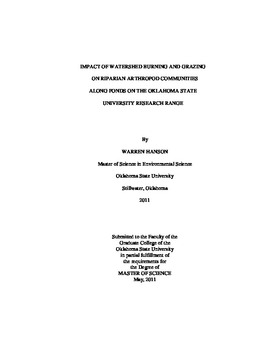| dc.description.abstract | Food webs in aquatic and terrestrial ecosystems have been subject to frequent studies, but interactions between these systems are not well understood. Energy flow between both aquatic and terrestrial systems establishes a complex food web that influences both systems. Riparian arthropods play an important role in the energy transfer between systems. This study evaluated the effects of range management practices on the riparian arthropod community within a cross timbers ecoregion. Following a controlled burn, with and without a vegetative buffer, changes in riparian arthropod communities were observed. Eight ponds (2 reference, 3 no buffer, 3 10m buffer) on the OSURR had samples taken from three habitat types (grass, trees, shrubs) prior to the burn, and weekly thereafter. Arthropod abundance at reference ponds increased over time. By the third week post-burn, both shrub and grass habitats at treatment ponds had higher mean arthropod abundance than reference ponds. Abundance values at treatment ponds peaked and then returned to near pre-burn levels, below values seen at reference ponds. Diversity indices indicated few significant differences. Shannon-Wiener increased initially, but leveled off by week four. Taxa evenness decreased initially, but by week four, treatment ponds had a higher evenness than reference ponds. Taxa richness values generally responded quickly, with constant responses throughout the treatment and reference ponds. Diptera were more abundant at the 10 m buffer treatment, with values significantly higher than no buffer treatment ponds at week two. Brachycera and Nematocera displayed similar results when separately analyzed. Araneae did not respond quickly; lower abundance values were observed throughout the study. At week three, a significantly higher mean abundance at reference ponds was observed. Auchenorrhyncha were lower in abundance for both treatments throughout than at reference ponds. Despite this, weeks two and four resulted in a significantly higher abundance at reference ponds. Coleoptera at treatment ponds were also found to have a delayed recovery, with low abundance values noted until week three. Overall, this study indicates that taxa specific responses occur following a rangeland burn. Some flying taxa (Diptera) responded quickly, while some predators (Coleoptera, Aranaeae) responded slowly. By the end of the study, it was presumed that the riparian system had begun to recover, with values returning to near pre-burn values. However, seasonal data would be necessary to establish a better picture of the recovery of the riparian arthropod community. | |
